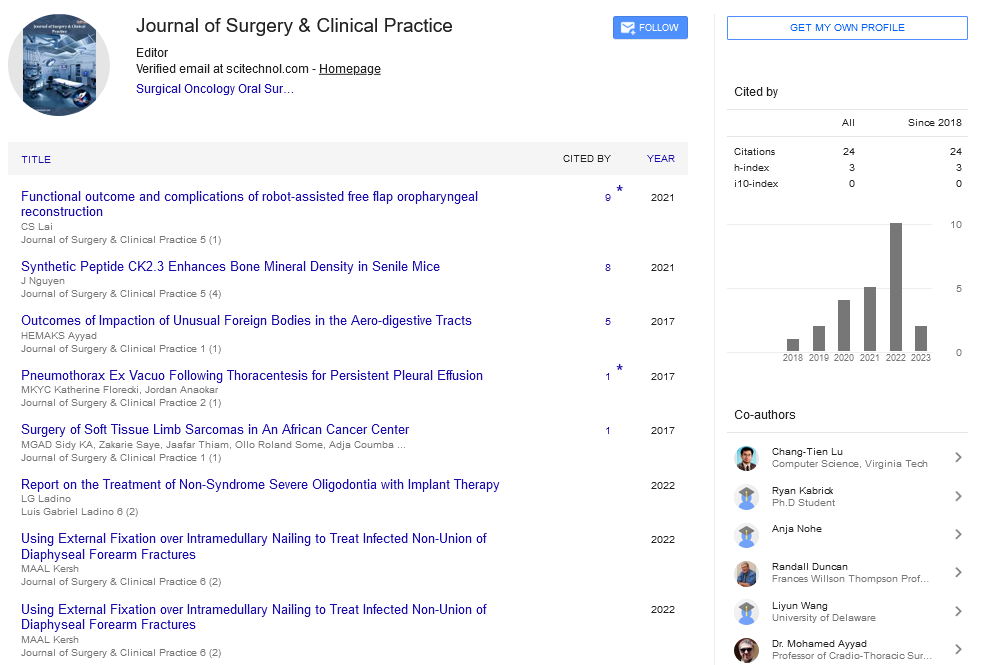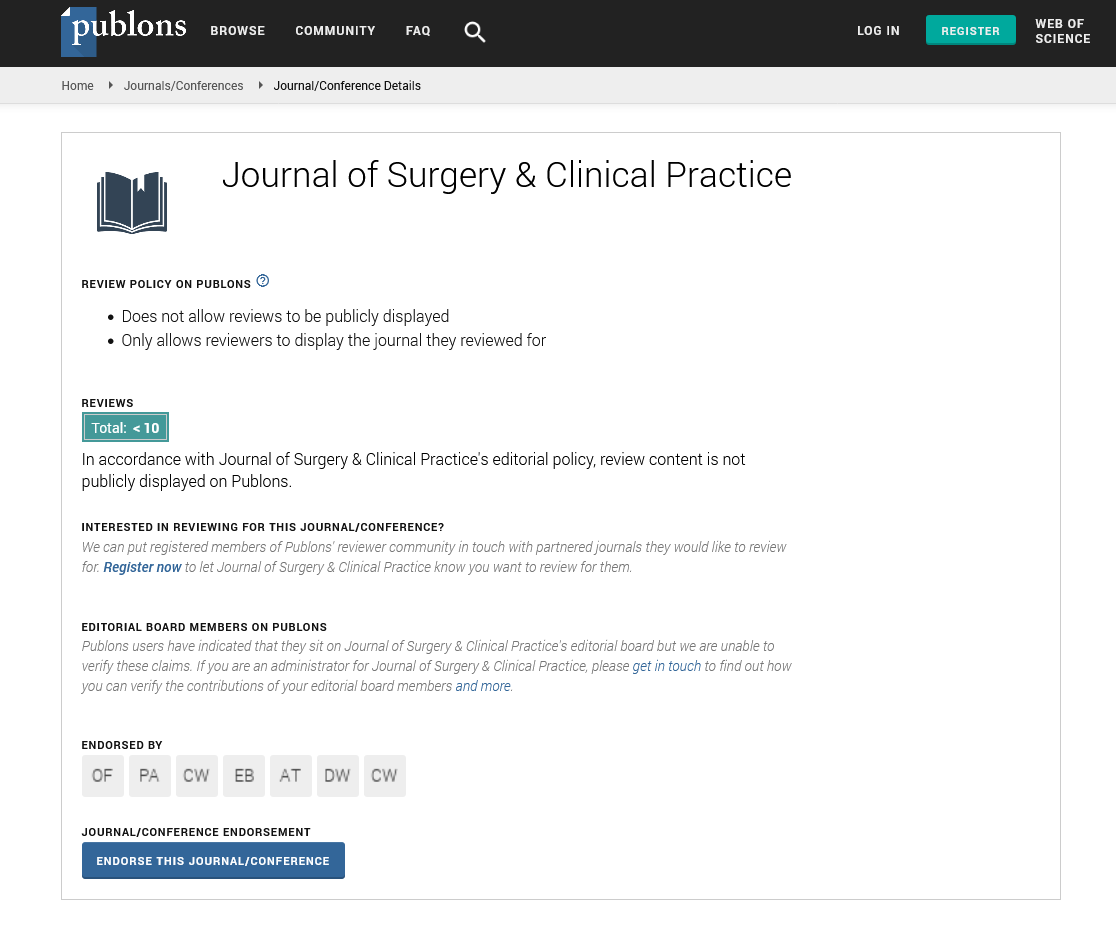Perspective, J Surgclinprac Vol: 6 Issue: 2
A Review of Lymphangiomas of the Tongue Pathophysiology, Clinical Signs and Symptoms, and Therapeutic Options
Ahmed Hassan Kamil Mustafa*
Department of Maxillofacial Surgery, Abdulaziz University for Health Sciences, Riyadh, Saudi Arabia
*Corresponding Author: Ahmed Hassan Kamil Mustafa
Department of Maxillofacial Surgery, Abdulaziz University for Health Sciences, Riyadh, Saudi Arabia
Email: kamilmustafahassanahmed@gmail.com
Received date: 03 March, 2022, Manuscript No. JSCP-22-56420;
Editor assigned date: 04 March, 2022, PreQC No. JSCP-22-56420(PQ);
Reviewed date: 15 March, 2022, QC No JSCP-22-56420;
Revised date: 25 March, 2022, Manuscript No. JSCP-22-56420(R);
Published date: : 01 April, 2022, DOI: 10.4712/jscp.1000359.
Citation: Mustafa ASH (2022) A Review of Lymphangiomas of the Tongue Pathophysiology, Clinical Signs and Symptoms, and Therapeutic Options. J Surg.Clin.Prac 6:2.
Keywords: Pathophysiology
Introduction
Lymphangioma is a benign lymphatic system hamartomatous abnormality that is more frequent in the head and neck region. Oral lymphangiomas are uncommon, but when they do occur, the tongue is the most usually afflicted region, with the palate, gingiva, and alveolar ridge of the mandible being less commonly affected. The goal of this study is to shed insight on lymphangioma of the tongue's pathophysiology, clinical signs and symptoms, and therapeutic options. Despite the fact that lymphangioma is benign and its occurrence in the tongue is exceedingly unusual, a health care practitioner such as a dentist must be aware of the presence of such a lesion in order to make an accurate diagnosis and as a result, correct treatment for this disorder can be provided to avoid major complications that may arise if it becomes damaged or infected, in which case it obstructs the airway and leads to the patient's death if not quickly rescued. Lymphangiomas are benign tumours involving lymphatic channels that, in the vast majority of instances, are restricted to the head and neck area. Lymphangiomas are frequent in children under the age of two. The front two-thirds of the tongue are the most usually implicated region in the oral cavity. This research intends to shed information on the pathophysiology, clinical signs and symptoms, categorization, and therapeutic options for tongue lymphangiomas. Within the electronic search of the databases was performed using a mix of keywords and control terms whenever possible. Lymphangioma and oral cavity, lymphangioma and tongue, lymphatic abnormalities, and tongue were among the search phrases.
Lymphatic System Hamartomatous Abnormality
Lymphangioma is a benign lymphatic system hamartomatous abnormality that is more frequent in the head and neck area. It develops as a result of the hyperplasia of isolated lymphatic vessels that have lost contact with the rest of the lymphatic system. In 1854, Virchow was the first to describe lymphangioma. The head and area have a high incidence of lymphangioma, with about 75% of cases occurring here. Lymphangimas are present at birth in 50% of cases and develop in 90% of cases by the age of two. The tongue is the most usually affected region in the oral cavity, with the palate, gingiva, and alveolar ridge of the mandible being impacted relatively rarely. Lymphangiomas are papillary lesions that are the same colour as the surrounding skin, as adjacent mucosa. Oral lymphangiomas have been linked to disorders such as Turner’s syndrome, noonan's syndrome, trisomies, cardiac anomalies, fetal hydrops, foetal alcohol syndrome, and familial pterygium colli in the past. Tongue lymphangiomas frequently have a pebbly appearance that looks like a collection of translucent vesicles. The front two-thirds of the tongue are the most typically impacted, resulting in tongue hypertrophy. Speech problems, poor oral hygiene, and tongue bleeding associated with trauma are common in tongue lymphangioma patients. The cosmetic, occlusal, functional, and psychological features of lymphangioma problems influence patients in a variety of ways. Infection-related problems, such as Ludwig's angina linked with an infected base of the tongue lymphangioma, are the most serious. Seroma development, infections, mild bleeding, recurrent cellulitis, and lymph fluid leaking are all postoperative problems. Lymphangiomas are defined by the growth of lymphatic channels bordered by endothelial cells on histological examination; the three forms are frequently encountered together in the same lesion. The cavernous lymphangioma is the most common of the three forms, and it can be found on the tongue and in the mouth floor. Lymphangiomes are characterized as macrocytic (cavities greater than approximately 2 cm), microcytic (cavities smaller than about 2 cm), or mixed based on their clinical appearance. These are the goals of lymphangiomatous and macroglossia treatment. Haemangioma, congenital hypothyroidism, amyloidosis, neurofibromatosis, and primary muscle hypertrophy are all possible diagnoses for lymphangioma. The kind, size, involvement of anatomical structures, and infiltration of adjacent tissues all influence lymphangioma treatment.
Infiltration of Adjacent Tissues in Lymphangioma Treatment
For the treatment of lymphangiomas, various treatment techniques have been tested, including laser therapy, cryotherapy, embolization, and electrocautery. Sclerosing drugs such as bleomycin and OK432 have been used to treat lymphangiomas, especially those affecting the tongue. Because OK432 does not produce perilesional fibrosis, it is considered the first line of treatment for lymphangiomas. OK432 is a lyophilized mixture of streptococcus pyogenic and penicillin G potassium. OK-432, a sclerosing drug, is beneficial for macro cystic lymphatic malformations but not for micro cystic lesions, mixed lesions, or lesions outside of the head and neck region. Fever and edoema at the injection site are common side effects of sclerosing drugs. Cryosurgery has also been used to treat lymphangiomas because of the high fluid content in the tissues and the lack of blood supply. In some cases, laser photocoagulation has been shown to be effective in reducing tongue size and eliminating superficial lymphangiomas. The most effective treatment for lymphangiomas is surgical excision. Because spontaneous lymphangioma regression is uncommon and most adult lymphangiomas are encapsulated or partially confined, surgical removal is preferred. Although lymphangioma is benign and its occurrence in the tongue is extremely rare, a health care provider such as a dentist must be aware of the presence of such a lesion in order to facilitate a precise diagnosis and, as a result, proper treatment for this disorder, to avoid the serious complications that can occur when it becomes traumatised or infected, in which case it obstructs the airway and can result in the patient's death if not quickly rescued. Whole-Body Computed Tomography (WBCT) is one of the standard non-invasive tests for trauma patients, to avoid the overuse of the WBCT and unnecessary radiation to the patients, a combination of evidence-based indications, approved guidelines and clinical decisions should be used. This study was done to emphasize on limitation of unnecessary WBCT following international or local criteria along with clinical assessment and decision without compromising the patient's safety. This study was done in the period from January 2020 to December 2020, the study population is poly trauma patients of the age of 18 years old and above, it is a descriptive, retrospective database analysis of 233 patients diagnosed with polytrauma in the emergency department, all patients were received by emergency physicians and trauma team members, where they received their initial management and stabilized then sent to the Radiology department for WBCT according to the order by senior physician or on-call surgeon who is a member of the trauma team, Informed consent was taken according to the hospital protocol.
 Spanish
Spanish  Chinese
Chinese  Russian
Russian  German
German  French
French  Japanese
Japanese  Portuguese
Portuguese  Hindi
Hindi 
